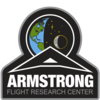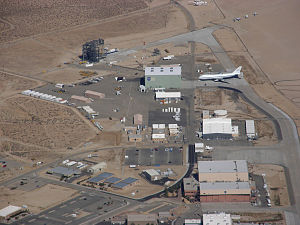
Edwards Air Force Base (AFB) is a United States Air Force installation in California. Most of the base sits in Kern County, but its eastern end is in San Bernadino County and a southern arm is in Los Angeles County. The hub of the base is Edwards, California. Established in the 1930s as Muroc Field, the facility was renamed Muroc Army Airfield and then Muroc Air Force Base before its final renaming in 1950 for World War II USAAF veteran and test pilot Capt. Glen Edwards.

The National Advisory Committee for Aeronautics (NACA) was a United States federal agency founded on March 3, 1915, to undertake, promote, and institutionalize aeronautical research. On October 1, 1958, the agency was dissolved and its assets and personnel were transferred to the newly created National Aeronautics and Space Administration (NASA). NACA is an initialism, i.e., pronounced as individual letters, rather than as a whole word.
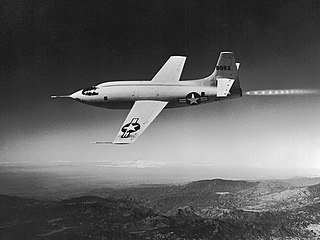
The Bell X-1 is a rocket engine–powered aircraft, designated originally as the XS-1, and was a joint National Advisory Committee for Aeronautics–U.S. Army Air Forces–U.S. Air Force supersonic research project built by Bell Aircraft. Conceived during 1944 and designed and built in 1945, it achieved a speed of nearly 1,000 miles per hour in 1948. A derivative of this same design, the Bell X-1A, having greater fuel capacity and hence longer rocket burning time, exceeded 1,600 miles per hour in 1954. The X-1 aircraft #46-062, nicknamed Glamorous Glennis and flown by Chuck Yeager, was the first piloted airplane to exceed the speed of sound in level flight and was the first of the X-planes, a series of American experimental rocket planes designed for testing new technologies.

The North American X-15 is a hypersonic rocket-powered aircraft. It was operated by the United States Air Force and the National Aeronautics and Space Administration as part of the X-plane series of experimental aircraft. The X-15 set speed and altitude records in the 1960s, crossing the edge of outer space and returning with valuable data used in aircraft and spacecraft design. The X-15's highest speed, 4,520 miles per hour, was achieved on 3 October 1967, when William J. Knight flew at Mach 6.7 at an altitude of 102,100 feet (31,120 m), or 19.34 miles. This set the official world record for the highest speed ever recorded by a crewed, powered aircraft, which remains unbroken.
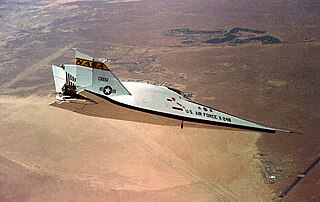
The Martin Marietta X-24 was an American experimental aircraft developed from a joint United States Air Force-NASA program named PILOT (1963–1975). It was designed and built to test lifting body concepts, experimenting with the concept of unpowered reentry and landing, later used by the Space Shuttle. Originally built as the X-24A, the aircraft was later rebuilt as the X-24B.

The Bell X-2 was an X-plane research aircraft built to investigate flight characteristics in the Mach 2–3 range. The X-2 was a rocket-powered, swept-wing research aircraft developed jointly in 1945 by Bell Aircraft Corporation, the United States Air Force and the National Advisory Committee for Aeronautics (NACA) to explore aerodynamic problems of supersonic flight and to expand the speed and altitude regimes obtained with the earlier X-1 series of research aircraft.

The Douglas D-558-2 Skyrocket is a rocket and jet-powered research supersonic aircraft built by the Douglas Aircraft Company for the United States Navy. On 20 November 1953, shortly before the 50th anniversary of powered flight, Scott Crossfield piloted the Skyrocket to Mach 2, or more than 1,290 mph (2076 km/h), the first time an aircraft had exceeded twice the speed of sound.

The NASA X-43 was an experimental unmanned hypersonic aircraft with multiple planned scale variations meant to test various aspects of hypersonic flight. It was part of the X-plane series and specifically of NASA's Hyper-X program developed in the late 1990s. It set several airspeed records for jet aircraft. The X-43 is the fastest jet-powered aircraft on record at approximately Mach 9.6.

The Northrop X-4 Bantam was a prototype small twinjet aircraft manufactured by Northrop Corporation in 1948. It had no horizontal tail surfaces, depending instead on combined elevator and aileron control surfaces for control in pitch and roll attitudes, almost exactly in the manner of the similar-format, rocket-powered Messerschmitt Me 163 of Nazi Germany's Luftwaffe. Some aerodynamicists had proposed that eliminating the horizontal tail would also do away with stability problems at fast speeds resulting from the interaction of supersonic shock waves from the wings and the horizontal stabilizers. The idea had merit, but the flight control systems of that time prevented the X-4 from achieving any success.

Joseph Albert Walker was an American World War II pilot, experimental physicist, NASA test pilot, and astronaut who was the first person to fly an airplane to space. He was one of twelve pilots who flew the North American X-15, an experimental spaceplane jointly operated by the Air Force and NASA.

Albert Scott Crossfield was an American naval officer and test pilot. In 1953, he became the first pilot to fly at twice the speed of sound. Crossfield was the first of twelve pilots who flew the North American X-15, an experimental spaceplane jointly operated by the United States Air Force and NASA.

The Bell Aerosystems Lunar Landing Research Vehicle was a Project Apollo era program to build a simulator for the Moon landings. The LLRVs were used by the FRC, now known as the NASA Armstrong Flight Research Center, at Edwards Air Force Base, California, to study and analyze piloting techniques needed to fly and land the Apollo Lunar Module in the Moon's low gravity environment.

Milton Orville Thompson, , better known as Milt Thompson, was an American naval officer, aviator, engineer, and NASA research pilot. He was one of twelve pilots who flew the North American X-15, an experimental spaceplane jointly operated by the United States Air Force and NASA.

The Douglas Skystreak was an American single-engine jet research aircraft of the 1940s. It was designed in 1945 by the Douglas Aircraft Company for the U.S. Navy Bureau of Aeronautics, in conjunction with the National Advisory Committee for Aeronautics (NACA). The Skystreaks were turbojet-powered aircraft that took off from the ground under their own power and had unswept flying surfaces.

The Northrop HL-10 was one of five US heavyweight lifting body designs flown at NASA's Flight Research Center in Edwards, California, from July 1966 to November 1975 to study and validate the concept of safely maneuvering and landing a low lift-over-drag vehicle designed for reentry from space. It was a NASA design and was built to evaluate "inverted airfoil" lifting body and delta planform. It currently is on display at the entrance to the Armstrong Flight Research Center at Edwards Air Force Base.

LASRE was NASA's Linear Aerospike SR-71 Experiment which took place at the Dryden Flight Research Center at Edwards Air Force Base, California, until November 1998. The experiment sought to provide flight data to help Lockheed Martin validate and tune the computational predictive tools used to determine the aerodynamic performance of the Lockheed Martin X-33 lifting body and linear aerospike engine combination and to lay groundwork for a future reusable launch vehicle.
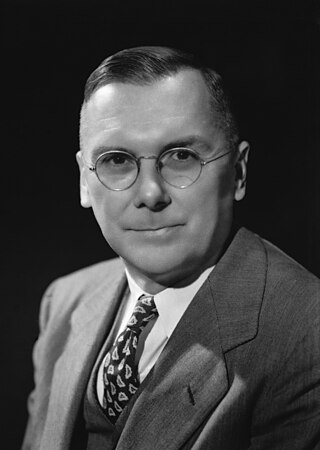
Hugh Latimer Dryden was an American aeronautical scientist and civil servant. He served as NASA Deputy Administrator from August 19, 1958, until his death.

John H. Griffith was a test pilot for the National Advisory Committee for Aeronautics, one of the pilots of the Bell X-1.
There are NASA facilities across the United States and around the world. NASA Headquarters in Washington, DC provides overall guidance and political leadership to the agency. There are 10 NASA field centers, which provide leadership for and execution of NASA's work. All other facilities fall under the leadership of at least one of these field centers. Some facilities serve more than one application for historic or administrative reasons. NASA has used or supported various observatories and telescopes, and an example of this is the NASA Infrared Telescope Facility. In 2013 a NASA Office of the Inspector General's (OIG) Report recommended a Base Realignment and Closure Commission (BRAC) style organization to consolidate NASA's little used facilities. The OIG determined at least 33 of NASA's 155 facilities were underutilized.

Walter Charles Williams was an American engineer, leader of the National Advisory Committee for Aeronautics (NACA) group at Edwards Air Force Base in the 1940s and 1950s, and a NASA deputy associate administrator during Project Mercury.
